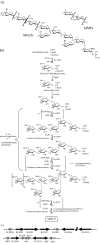Polymethylated polysaccharides from Mycobacterium species revisited
- PMID: 18786916
- PMCID: PMC2629103
- DOI: 10.1074/jbc.R800047200
Polymethylated polysaccharides from Mycobacterium species revisited
Abstract
Mycobacteria produce two sets of unusual polymethylated polysaccharides, the 3-O-methylmannose polysaccharides and the 6-O-methylglucose lipopolysaccharides. Both polysaccharides localize to the cytoplasm, where they have been postulated to regulate fatty acid metabolism due to their ability to form stable 1:1 complexes with fatty acyl chains. Physiological evidence for this assumption is lacking, however. Recent advances in our knowledge of the processes underlying sugar transfer in mycobacteria, together with the availability of genome sequences and tools for the genetic manipulation of these microorganisms, have opened the way to the elucidation of the biosynthetic pathways and biological functions of these unique carbohydrates.
Figures


Similar articles
-
Biosynthesis of mycobacterial methylmannose polysaccharides requires a unique 1-O-methyltransferase specific for 3-O-methylated mannosides.Proc Natl Acad Sci U S A. 2019 Jan 15;116(3):835-844. doi: 10.1073/pnas.1813450116. Epub 2019 Jan 3. Proc Natl Acad Sci U S A. 2019. PMID: 30606802 Free PMC article.
-
Biosynthesis of mycobacterial methylglucose lipopolysaccharides.Nat Prod Rep. 2012 Aug;29(8):834-44. doi: 10.1039/c2np20014g. Epub 2012 Jun 8. Nat Prod Rep. 2012. PMID: 22678749
-
Genetic basis for the biosynthesis of methylglucose lipopolysaccharides in Mycobacterium tuberculosis.J Biol Chem. 2007 Sep 14;282(37):27270-27276. doi: 10.1074/jbc.M702676200. Epub 2007 Jul 19. J Biol Chem. 2007. PMID: 17640872
-
Amphiphilic cytosolic glycans from mycobacteria: occurrence, lipid-binding properties, biosynthesis, and synthesis.Biopolymers. 2013 Oct;99(10):697-712. doi: 10.1002/bip.22290. Biopolymers. 2013. PMID: 23703393 Review.
-
Haemoglobins of Mycobacteria: structural features and biological functions.Adv Microb Physiol. 2013;63:147-94. doi: 10.1016/B978-0-12-407693-8.00005-4. Adv Microb Physiol. 2013. PMID: 24054797 Review.
Cited by
-
Allosteric regulation of the partitioning of glucose-1-phosphate between glycogen and trehalose biosynthesis in Mycobacterium tuberculosis.Biochim Biophys Acta. 2015 Jan;1850(1):13-21. doi: 10.1016/j.bbagen.2014.09.023. Epub 2014 Sep 30. Biochim Biophys Acta. 2015. PMID: 25277548 Free PMC article.
-
A Subset of Protective γ9δ2 T Cells Is Activated by Novel Mycobacterial Glycolipid Components.Infect Immun. 2016 Aug 19;84(9):2449-62. doi: 10.1128/IAI.01322-15. Print 2016 Sep. Infect Immun. 2016. PMID: 27297390 Free PMC article.
-
Lipoarabinomannan and related glycoconjugates: structure, biogenesis and role in Mycobacterium tuberculosis physiology and host-pathogen interaction.FEMS Microbiol Rev. 2011 Nov;35(6):1126-57. doi: 10.1111/j.1574-6976.2011.00276.x. Epub 2011 May 31. FEMS Microbiol Rev. 2011. PMID: 21521247 Free PMC article. Review.
-
Effect of Homocysteine on Biofilm Formation by Mycobacteria.Indian J Microbiol. 2018 Sep;58(3):287-293. doi: 10.1007/s12088-018-0739-8. Epub 2018 May 16. Indian J Microbiol. 2018. PMID: 30013272 Free PMC article.
-
Mycobacterium hassiacum recovers from nitrogen starvation with up-regulation of a novel glucosylglycerate hydrolase and depletion of the accumulated glucosylglycerate.Sci Rep. 2014 Oct 24;4:6766. doi: 10.1038/srep06766. Sci Rep. 2014. PMID: 25341489 Free PMC article.
References
-
- Berg, S., Kaur, D., Jackson, M., and Brennan, P. J. (2007) Glycobiology 17 35R–56R - PubMed
-
- Lee, Y. C., and Ballou, C. E. (1964) J. Biol. Chem. 239 PC3602–PC3603 - PubMed
-
- Lee, Y. C. (1966) J. Biol. Chem. 241 1899–1908 - PubMed
-
- Gray, G. R., and Ballou, C. E. (1971) J. Biol. Chem. 246 6835–6842 - PubMed
-
- Hunter, S. W., Gaylord, H., and Brennan, P. J. (1986) J. Biol. Chem. 261 12345–12351 - PubMed
Publication types
MeSH terms
Substances
Grants and funding
LinkOut - more resources
Full Text Sources

